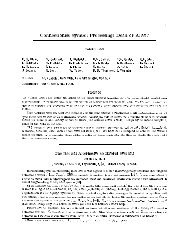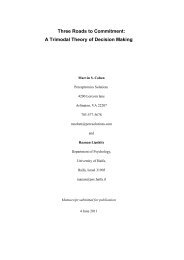Three Roads to Commitment: A Trimodal Theory of Decision Making
Three Roads to Commitment: A Trimodal Theory of Decision Making
Three Roads to Commitment: A Trimodal Theory of Decision Making
You also want an ePaper? Increase the reach of your titles
YUMPU automatically turns print PDFs into web optimized ePapers that Google loves.
<strong>Three</strong> <strong>Roads</strong> <strong>to</strong> <strong>Commitment</strong>: A <strong>Trimodal</strong> <strong>Theory</strong> <strong>of</strong> <strong>Decision</strong> <strong>Making</strong> 11<br />
Suhr, 2009; Klein, 1993), inference from theory, or responsiveness <strong>to</strong> dissent expressed by other informed parties<br />
(Wal<strong>to</strong>n, 1998; van Eemeren & Grootendorst, 1992). Whether reassessment is based on practice or deliberation,<br />
decisions are justified by reasons <strong>of</strong> the form, Continue A because it survived challenges, or Do not continue<br />
[aspects or parts <strong>of</strong>] A because it failed <strong>to</strong> survive challenges. If elements <strong>of</strong> an intention are rejected, the<br />
commitments are less specific or less comprehensive than they were before reassessment. If a replacement is not<br />
waiting in the wings or has not become obvious, what follows is usually a renewal <strong>of</strong> matching <strong>to</strong> find or create one.<br />
Reassessment is the backup strategy for commitments made on the basis <strong>of</strong> incomplete information – as most<br />
commitments are in real world environments. Fortunately, it has impeccable normative Backing. The rationale for<br />
continued commitment <strong>to</strong> a practice or plan is that it has been tested – i.e., exposed <strong>to</strong> the possibility <strong>of</strong> relevant new<br />
information or Rebuttals – and has so far survived; i.e., it works. It has been argued along Darwinian lines (e.g.,<br />
Dennett, 1996) that genuinely new knowledge (i.e., the appearance <strong>of</strong> design when there is no omniscient designer)<br />
can only emerge from some version <strong>of</strong> trial and error, or generate and test. Differential empirical success (which is<br />
the basis for reassessment) appears <strong>to</strong> influence the survival and shape <strong>of</strong> organisms (Gould, 1977), behavior (e.g.,<br />
Sut<strong>to</strong>n & Bar<strong>to</strong>, 1998; Skinner, 1953), and ideas (Popper 1994, 1969; Dawkins, 2006), respectively.<br />
Reassessment may begin at any time after the decision maker commits <strong>to</strong> an intention, as long as commitments<br />
<strong>to</strong> future parts <strong>of</strong> an on-going activity, or future repetitions <strong>of</strong> a practice, are not yet irreversible. <strong>Commitment</strong><br />
excludes baseless reassessment (see criterion (a) above), but when the course <strong>of</strong> action is a general practice or longterm<br />
plan, the need for small improvisations and adjustments may be anticipated. If major difficulties occur or if<br />
minor ones accumulate, reassessment kicks in<strong>to</strong> higher gear and the core commitment may be in jeopardy.<br />
Reassessment presupposes what Schön (1983) has called double vision: A decision maker can both commit <strong>to</strong> a<br />
course <strong>of</strong> action and simultaneously be aware, at least implicitly, <strong>of</strong> the possibility <strong>of</strong> problems <strong>of</strong> any size.<br />
Choice<br />
Choice seeks the most efficient means <strong>to</strong> desired ends. It begins with a commitment <strong>to</strong> select one action from a<br />
set <strong>of</strong> two or more mutually exclusive alternatives, framed by the question, Which <strong>of</strong> these options is the best means<br />
<strong>to</strong> my ends The Warrant for choice is maximization <strong>of</strong> the expected desirability <strong>of</strong> future states. The Grounds, and<br />
the focus <strong>of</strong> attention during decision making, are alternative courses <strong>of</strong> action and their estimated consequences.<br />
Using these Grounds, the choice process seeks <strong>to</strong> reduce the mutually exclusive disjunctive intention (e.g., <strong>to</strong> do A<br />
or B – but not both) <strong>to</strong> a singular intention <strong>to</strong> perform one <strong>of</strong> the given options (e.g., <strong>to</strong> do A). Selections are justified<br />
by reasons <strong>of</strong> the form, Do A because it is [a part or aspect <strong>of</strong>] the most efficient available means <strong>to</strong> my ends.




